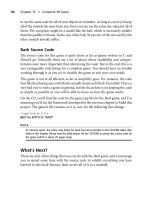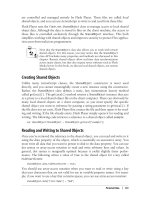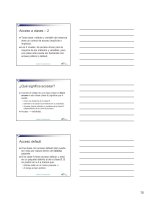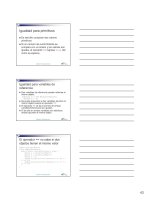java programming language basics phần 9 pps
Bạn đang xem bản rút gọn của tài liệu. Xem và tải ngay bản đầy đủ của tài liệu tại đây (116.83 KB, 14 trang )
Constructor
The window title is set by calling the getString method on the
ResourceBundle, and passing it the keyword that maps to the title text.
You must pass the keyword exactly as it appears in the translation file, or
you will get a runtime error indicating the resource is unavailable.
RMIClient1(){
//Set window title
setTitle(messages.getString("title"));
The next thing the constructor does is use the args parameter to look up
the remote server object. If there are any errors in this process, the
catch statements get the applicable error text from the
ResourceBundle and print it to the command line. User interface objects
that display text, such as JLabel and JButton, are created in the same
way:
//Create left and right column labels
col1 = new JLabel(messages.getString("1col"));
col2 = new JLabel(messages.getString("2col"));
//Create buttons and make action listeners
purchase = new JButton(messages.getString(
"purchase"));
purchase.addActionListener(this);
reset = new JButton(messages.getString("reset"));
reset.addActionListener(this);
actionPerformed Method
In the actionPerformed method, the Invalid Value error is caught
and translated:
if(order.apples.length() > 0){
//Catch invalid number error
try{
applesNo = Integer.valueOf(order.apples);
order.itotal += applesNo.intValue();
}catch(java.lang.NumberFormatException e){
appleqnt.setText(messages.getString("invalid"));
}
} else {
order.itotal += 0;
}
The actionPerformed method calculates item and cost totals,
translates them to the correct format for the language currently in use, and
displays them in the user interface.
Internationalize Numbers
A NumberFormat object is used to translate numbers to the correct
format for the language currently in use. To do this, a NumberFormat
8 of 12 21-04-2000 17:34
Java(TM) Language Basics, Part 2, Lesson 6: Internationalization raining/Programming/BasicJava2/int.html
object is created from the
currentLocale
. The information in the
currentLocale tells the NumberFormat object what number format to
use.
Once you have a NumberFormat object, all you do is pass in the value
you want translated, and you receive a String that contains the number
in the correct format. The value can be passed in as any data type used
for numbers such as int, Integer, double, or Double. No code such
as to convert an Integer to an int and back again is needed.
//Create number formatter
numFormat = NumberFormat.getNumberInstance(
currentLocale);
//Display running total
text = numFormat.format(order.itotal);
this.items.setText(text);
//Calculate and display running cost
order.icost = (order.itotal * 1.25);
text2 = numFormat.format(order.icost);
this.cost.setText(text2);
try{
send.sendOrder(order);
} catch (java.rmi.RemoteException e) {
System.out.println(messages.getString("send"));
}
Compile and Run the Application
Here are the summarized steps for compiling and running the example
program. The important thing to note is that when you start the client
programs, you need to include language and country codes if you want a
language other than United States English.
Compile
These instructions assume development is in the zelda home directory.
Unix:
cd /home/zelda/classes
javac Send.java
javac RemoteServer.java
javac RMIClient2.java
javac RMIClient1.java
rmic -d . RemoteServer
cp RemoteServer*.class /home/zelda/public_html/classes
cp Send.class /home/zelda/public_html/classes
cp DataOrder.class /home/zelda/public_html/classes
Win32:
cd \home\zelda\classes
javac Send.java
javac RemoteServer.java
javac RMIClient2.java
javac RMIClient1.java
9 of 12 21-04-2000 17:34
Java(TM) Language Basics, Part 2, Lesson 6: Internationalization raining/Programming/BasicJava2/int.html
rmic -d . RemoteServer
copy RemoteServer*.class
\home\zelda\public_html\classes
copy Send.class \home\zelda\public_html\classes
copy DataOrder.class \home\zelda\public_html\classes
Start rmi Registry
Unix:
cd /home/zelda/public_html/classes
unsetenv CLASSPATH
rmiregistry &
Win32:
cd \home\zelda\public_html\classes
set CLASSPATH=
start rmiregistry
Start the Server
Unix:
cd /home/zelda/public_html/classes
java -Djava.rmi.server.codebase=
http://kq6py/~zelda/classes
-Dtava.rmi.server.hostname=kq6py.eng.sun.com
-Djava.security.policy=java.policy RemoteServer
Win32:
cd \home\zelda\public_html\classes
java -Djava.rmi.server.codebase=
file:c:\home\zelda\public_html\classes
-Djava.rmi.server.hostname=kq6py.eng.sun.com
-Djava.security.policy=java.policy RemoteServer
Start RMIClient1 in German
Note the addition of de DE for the German language and country at the
end of the line.
Unix:
cd /home/zelda/classes
java -Djava.rmi.server.codebase=
http://kq6py/~zelda/classes/
-Djava.security.policy=java.policy
RMIClient1 kq6py.eng.sun.com de DE
Win32:
cd \home\zelda\classes
java -Djava.rmi.server.codebase=
file:c:\home\zelda\classes\
-Djava.security.policy=java.policy RMIClient1
kq6py.eng.sun.com de DE
10 of 12 21-04-2000 17:34
Java(TM) Language Basics, Part 2, Lesson 6: Internationalization raining/Programming/BasicJava2/int.html
Start RMIClient2 in French
Note the addition of fr FR for the French language and country at the end
of the line.
Unix:
cd /home/zelda/classes
java -Djava.rmi.server.codebase=
http://kq6py/~zelda/classes
-Djava.rmi.server.hostname=kq6py.eng.sun.com
-Djava.security.policy=java.policy
RMIClient2 kq6py.eng.sun.com fr FR
Win32:
cd \home\zelda\classes
java -Djava.rmi.server.codebase=
file:c:\home\zelda\public_html\classes
-Djava.rmi.server.hostname=kq6py.eng.sun.com
-Djava.security.policy=java.policy RMIClient2
kq6py.eng.sun.com/home/zelda/public_html fr FR
Program Improvements
A real-world scenario for an ordering application like this might be that
RMIClient1
is an applet embedded in a web page. When orders are
submitted, order processing staff run RMIClient2
as applications from their
local machines.
So, an interesting exercise is to convert RMIClient1.java to its applet
equivalent. The translation files would be loaded by the applet from the
same directory from which the browser loads the applet class.
One way is to have a separate applet for each language with the language
and country codes hard coded. Your web page can let them choose the
language by clicking a link that launches the appropriate applet. Here are
the source code files for the English
, French, and German applets.
Here is the HTML code to load the French applet on a Web page.
<HTML>
<BODY>
<APPLET CODE=RMIFrenchApp.class WIDTH=300 HEIGHT=300>
</APPLET>
</BODY>
</HTML>
Note: To run an applet written with Java
TM
2 APIs in a browser,
the browser must be enabled for the Java 2 Platform. If your
browser is not enabled for the Java 2 Platform, you have to use
appletviewer to run the applet or install Java Plug-in
. Java Plug-in
lets you run applets on web pages under the 1.2 version of the
Java
1
virtual machine (VM) instead of the web browser's default
Java VM.
11 of 12 21-04-2000 17:34
Java(TM) Language Basics, Part 2, Lesson 6: Internationalization raining/Programming/BasicJava2/int.html
To use applet viewer, type the following where rmiFrench.html is the
HTML file for the French applet.
appletviewer rmiFrench.html
Another improvement to the program as it currently stands would be
enhancing the error message text. You can locate the errors in the Java
API docs and use the information there to make the error message text
more user friendly by providing more specific information.
You might also want to adapt the client programs to catch and handle the
error thrown when an incorrect keyword is used. Here are the error and
stack trace provided by the system when this type of error occurs:
Exception in thread "main"
java.util.MissingResourceException:
Can't find resource
at java.util.ResourceBundle.getObject(Compiled Code)
at java.util.ResourceBundle.getString(Compiled Code)
at RMIClient1.<init>(Compiled Code)
at RMIClient1.main(Compiled Code)
More Information
You can find more information on Internationalization in the
Internationalization
trail in The Java Tutorial.
You can find more informationon applets in the Writing Applets trail in The
Java Tutorial.
_______
1
As used on this web site, the terms "Java virtual machine" or "JVM"
mean a virtual machine for the Java platform
[TOP]
[ This page was updated: 31-Mar-2000 ]
Products & APIs | Developer Connection | Docs & Training | Online Support
Community Discussion | Industry News | Solutions Marketplace | Case Studies
Glossary - Applets - Tutorial - Employment - Business & Licensing - Java Store - Java in the Real World
FAQ | Feedback | Map | A-Z Index
For more information on Java technology
and other software from Sun Microsystems, call:
(800) 786-7638
Outside the U.S. and Canada, dial your country's
AT&T Direct Access Number
first.
Copyright © 1995-2000 Sun Microsystems, Inc.
All Rights Reserved. Terms of Use. Privacy Policy.
12 of 12 21-04-2000 17:34
Java(TM) Language Basics, Part 2, Lesson 6: Internationalization raining/Programming/BasicJava2/int.html
Java
TM
Programming Language Basics, Part 2
Lesson 7: Packages and Java
TM
Archive File Format
[<<BACK] [CONTENTS] [
NEXT>>
Until now, you have used classes from the Java API library by importing the
package containing the class or classes you need. A package is a convenient
way to organize groups of related classes, and in development, you should
organize your application files into packages too. Packages make it easier to
locate and use the class files and help you control access to class data at run
time.
When your application is fully tested, debugged, and ready for deployment,
use the Java
TM
Archive file format to deploy the application. JAR file format is
a compression and file packaging format and tool for bundling executable files
with any other related application files so they can be deployed as one unit.
This lesson shows you how to organize the program files from
Part 2, Lesson
6: Internationalization into packages and deploy the executable and other
related files to production using JAR file format. Normally, you would use
packages from the beginning of development.
Setting up Class Packages
Create the Directories
Declare the Packages
Make Classes and Fields Accessible
Change Client Code to Find the Properties File
Compile and Run the Example
Using JAR Files to Deploy
Server Set of Files
Fruit Order Client Set of Files
View Order Client Set of Files
More Information
Setting up Class Packages
It is easy to organize class files into packages. All you do is put related class
files in the same directory, give the directory a name that relates to the
purpose of the classes, and add a line to the top of each class file that
declares the package name, which is the same as the directory name where
they reside.
For example, the class and other related files for the program files from
Part
2, Lesson 6: Internationalization
can be divided into three groups of files: fruit
order client, view order client, and server files. Although these three sets of
classes are related to each other, they have different functions and are to be
1 of 9 21-04-2000 17:34
Java (TM) Language Basics, Part 2, Lesson 7: Packages and Java Archive (JAR) raining/Programming/BasicJava2/jar.html
deployed separately.
Create the Directories
To organize the internationalization program into three packages, you could
create the following three directories and move the listed source files into
them:
client1
RMIEnglishApp.java
RMIFrenchApp.java
RMIGermanApp.java
MessagesBundle_de_DE.properties
MessagesBundle_en_US.properties
MessagesBundle_fr_FR.properties
index.html
rmiFapp.html
rmiGapp.html
rmiEapp.html
java.policy
client2
RMIClient2.java
MessagesBundle_de_DE.properties
MessagesBundle_en_US.properties
MessagesBundle_fr_FR.properties
java.policy
server
DataOrder.java
RemoteServer.java
Send.java
java.policy
Declare the Packages
Each *.java file needs a package delcaration at the top that reflects the
name of the directory. Also, the fruit order (client1 and view order
(client2
) client class files need an import statement for the server package
because they have to access the remote server object at runtime.
As an example, the package declaration and import statements for the
RMIClient2.java class file look like this:
//package declaration
package client2;
import java.awt.Color;
import java.awt.GridLayout;
import java.awt.event.*;
import javax.swing.*;
import java.io.*;
import java.net.*;
import java.rmi.*;
import java.rmi.server.*;
2 of 9 21-04-2000 17:34
Java (TM) Language Basics, Part 2, Lesson 7: Packages and Java Archive (JAR) raining/Programming/BasicJava2/jar.html
import java.util.*;
import java.text.*;
//Import server package
import server.*;
Make Classes and Fields Accessible
With class files organized into packages, you have to declare the server
classes in the server directory public
so they can be instantiated by client
programs, which are created from classes in the client1 and client2
directories. If you do not specify public
, a class can only be instantiated by
an object created from a class in the same package.
So client programs can access the fruit order data, the fields of the
DataOrder class have to be public too. The RemoteServer class and
Send interface need to be public
classes, but their fields do not need to be
public because the do not have public data.
Fields and methods without an access specifier such as public
can only be
accessed by objects created from classes in the same package.
Here is the new DataOrder
class.
package server;
import java.io.*;
//Make class public
public class DataOrder implements Serializable{
//Make fields public
public String apples, peaches, pears, cardnum, custID;
public double icost;
public int itotal;
}
Change Client Code to Find the Properties Files
In the example, the properties files (Messages_*) are stored in the
directories with the client source files. This makes it easier to package and
deploy the files later. So the programs can field the properties files, you have
to make one small change to the client source code.
The code that creates the messages
variable needs to include the directory
(package name) as follows:
messages = ResourceBundle.getBundle(
"client2" +
File.separatorChar +
"MessagesBundle", currentLocale);
Compile and Run the Example
Compiling and running the example organized into packages is a little different
3 of 9 21-04-2000 17:34
Java (TM) Language Basics, Part 2, Lesson 7: Packages and Java Archive (JAR) raining/Programming/BasicJava2/jar.html
from compiling and running the example in previous lessons. First, you have to
execute the compiler and interpreter commands from one directory above the
package directories, and second, you have to specify the package directories
to the compiler and interpreter commands.
Compile
These instructions assume development occurs in the zelda
home directory.
Unix:
cd /home/zelda/classes
javac server/Send.java
javac server/RemoteServer.java
javac client2/RMIClient2.java
javac client1/RMIFrenchApp.java
javac client1/RMIGermanApp.java
javac client1/RMIEnglishApp.java
rmic -d . server.RemoteServer
cp server/RemoteServer*.class
/home/zelda/public_html/classes
cp server/Send.class
/home/zelda/public_html/classes
cp server/DataOrder.class
/home/zelda/public_html/classes
Win32:
cd \home\zelda\classes
javac server\Send.java
javac server\RemoteServer.java
javac client2\RMIClient2.java
javac client1\RMIFrenchApp.java
javac client1\RMIGermanApp.java
javac client1\RMIEnglishApp.java
rmic -d . server.RemoteServer
copy server\RemoteServer*.class
\home\zelda\public_html\classes
copy server\Send.class
\home\zelda\public_html\classes
copy server\DataOrder.class
\home\zelda\public_html\classes
Note: The rmic -d . server.RemoteServer line uses
server.RemoteServer instead of server/RemoteServer so
the _stub and _skel classes are generated properly with the
package.
Start rmi Registry:
Unix:
cd /home/zelda/public_html/classes
unsetenv CLASSPATH
rmiregistry &
Win32:
4 of 9 21-04-2000 17:34
Java (TM) Language Basics, Part 2, Lesson 7: Packages and Java Archive (JAR) raining/Programming/BasicJava2/jar.html
cd \home\zelda\public_html\classes
set CLASSPATH=
start rmiregistry
Start the Server
Unix:
cd /home/zelda/public_html/classes
java -Djava.rmi.server.codebase=
http://kq6py/~zelda/classes
-Djava.rmi.server.hostname=kq6py.eng.sun.com
-Djava.security.policy=
server/java.policy server/RemoteServer
Win32:
cd \home\zelda\public_html\classes
java -Djava.rmi.server.codebase=
file:c:\home\zelda\public_html\classes
-Djava.rmi.server.hostname=kq6py.eng.sun.com
-Djava.security.policy=
server\java.policy server\RemoteServer
Start RMIGermanApp Here is the HTML code to load the German applet,
Note the directory/package name prefixed to the applet class name
(client1/RMIGermanApp.class).
<HTML>
<BODY>
<APPLET CODE=client1/RMIGermanApp.class WIDTH=300 HEIGHT=300>
</APPLET>
</BODY>
</HTML>
To run the applet with appletviewer, invoke the HTML file from the directory
just above client1 as follows:
cd /home/zelda/classes
appletviewer rmiGapp.html
Start RMIClient2 in French
Unix:
cd /home/zelda/classes
java -Djava.rmi.server.codebase=
http://kq6py/~zelda/classes
-Djava.rmi.server.hostname=kq6py.eng.sun.com
-Djava.security.policy=client2/java.policy
client2/RMIClient2 kq6py.eng.sun.com fr FR
Win32:
cd \home\zelda\classes
java -Djava.rmi.server.codebase=
file:c:\home\zelda\public_html\classes
5 of 9 21-04-2000 17:34
Java (TM) Language Basics, Part 2, Lesson 7: Packages and Java Archive (JAR) raining/Programming/BasicJava2/jar.html
-Djava.rmi.server.hostname=kq6py.eng.sun.com
-Djava.security.policy=client2\java.policy
client2\RMIClient2 kq6py.eng.sun.com fr FR
Using JAR Files to Deploy
After testing and debugging, the best way to deploy the two client and server
files is to bundle the executables and other related application files into three
separate JAR files, one JAR file for each client program, and one JAR file for
the server program.
JAR files use the ZIP file format to compress and pack files into, and
decompress and unpack files from, the JAR file. JAR files make it easy to
deploy programs that consist of many files. Browsers can easily download
applets bundled into JAR files, and the download goes much more quickly
than if the applet and its related files were not bundled into a JAR file.
Server Set of Files
Here are the server files:
RemoteServer.class
RemoteServer_skel.class
RemoteServer_stub.class
Send.class
DataOrder.class
java.policy
Compress and Pack Server Files
To compress and pack the server files into one JAR file, type the following
command on one line. This command is executed in the same directory with
the files. If you execute the command from a directory other than where the
files are, you have to specify the full pathname.
jar cf server.jar
RemoteServer.class
RemoteServer_skel.class
RemoteServer_stub.class
Send.class
DataOrder.class
java.policy
jar is the jar command. If you type jar with no options, you get the
following help screen. You can see from the help screen that the cf
options
to the jar command mean create a new JAR file named server.jar
and
put the list of files that follows into it. The new JAR file is placed in the current
directory.
kq6py% jar
Usage: jar {ctxu}[vfm0M] [jar-file] [manifest-file]
[-C dir] files
Options:
-c create new archive
-t list table of contents for archive
6 of 9 21-04-2000 17:34
Java (TM) Language Basics, Part 2, Lesson 7: Packages and Java Archive (JAR) raining/Programming/BasicJava2/jar.html
-x extract named (or all) files from archive
-u update existing archive
-v generate verbose output on standard output
-f specify archive file name
-m include manifest information from specified
manifest file
-0 store only; use no ZIP compression
-M Do not create a manifest file for the entries
-C change to the specified directory and
include the following file
If any file is a directory then it is processed
recursively.
The manifest file name and the archive file name
needs to be specified in the same order the
'm' and 'f' flags are specified.
Example 1: to archive two class files into an
archive called classes.jar:
jar cvf classes.jar Foo.class Bar.class
Example 2: use an existing manifest file 'mymanifest'
and archive all the files in the foo/ directory
into 'classes.jar':
jar cvfm classes.jar mymanifest -C foo/ .
To deploy the server files, all you have to do is move the server.jar
file to
a publicly accessible directory on the server where they are to execute.
Decompress and Unpack Server Files
After moving the JAR file to its final location, the compressed and packed files
need to be decompressed and unpacked so you can start the server. The
following command means extract (x) all files from the server.jar file (f
).
jar xf server.jar
Fruit Order Set of Files
The fruit order set of files (below) consists of applet classes, web pages,
translation files, and the policy file. Because they live on the web, they need
to be in a directory accessible by the web server. The easiest way to deploy
these files is to bundle them all into a JAR file and copy them to their location.
RMIEnglishApp.class
RMIFrenchApp.class
RMIGermanApp.class
index.html (top-level web page where user chooses language)
rmiEapp.html (second-level web page for English)
rmiFapp.html (second-level web page for French)
rmiGapp.html (second-level web page for German)
MessagesBundle_de_DE.properties
MessagesBundle_en_US.properties
MessagesBundle_fr_FR.properties
java.policy
Compress and Pack Files
7 of 9 21-04-2000 17:34
Java (TM) Language Basics, Part 2, Lesson 7: Packages and Java Archive (JAR) raining/Programming/BasicJava2/jar.html
jar cf applet.jar
RMIEnglishApp.class
RMIFrenchApp.class
RMIGermanApp.class
index.html
rmiEapp.html
rmiFapp.html
rmiGapp.html
MessagesBundle_de_DE.properties
MessagesBundle_en_US.properties
MessagesBundle_fr_FR.properties
java.policy
To deploy the fruit order client files, copy the applet.jar file to its final
location.
Decompress and Unpack Files
An applet in a JAR file can be invoked from an HTML file without being
unpacked. All you do is specify the ARCHIVE option to the APPLET tag in
your web page, which tells appletviewer the name of the JAR file containing
the class file. Be sure to include the package directory when you specify the
applet class to the CODE option.
You can leave the translation files and policy file in the JAR file. When using
appletviewer, the applet invoked from the JAR file will find them in the JAR
file.
<HTML>
<BODY>
<APPLET CODE=client1/RMIFrenchApp.class
ARCHIVE="applet.jar"
WIDTH=300
HEIGHT=300>
</APPLET>
</BODY>
</HTML>
However, you do need to unpack the web pages so you can move them to
their final location. The following command does this. Everything goes on one
line.
jar xv applet.jar index.html
rmiEapp.html
rmiFapp.html
rmiGapp.html
Note: To run the HTML files from a browser, you need to unpack
the JAR file, copy the java.policy file to your home directory and
make sure it has the right name (.java.policy for Unix and
java.policy for Windows), and install Java Plug-In.
View Order Set of Files
8 of 9 21-04-2000 17:34
Java (TM) Language Basics, Part 2, Lesson 7: Packages and Java Archive (JAR) raining/Programming/BasicJava2/jar.html
The view order set of files (below) consists of the application class file and
the policy file.
RMIClient2.class
java.policy
Compress and Pack Files
jar cf vieworder.jar RMIClient2.class java.policy
To deploy the view order client files, copy the vieworder.jar
file to its final
location.
Decompress and Unpack Files
jar xf vieworder.jar
More Information
You can find more information on packages in the Creating and Using
Packages lesson in The Java Tutorial.
You can find more information on these and other JAR file format topics in the
JAR File Format trail in The Java Tutorial.
[
TOP
[ This page was updated: 30-Mar-2000 ]
Products & APIs | Developer Connection | Docs & Training | Online Support
Community Discussion | Industry News | Solutions Marketplace | Case Studies
Glossary - Applets - Tutorial - Employment - Business & Licensing - Java Store - Java in the Real World
FAQ | Feedback | Map | A-Z Index
For more information on Java technology
and other software from Sun Microsystems, call:
(800) 786-7638
Outside the U.S. and Canada, dial your country's
AT&T Direct Access Number
first.
Copyright © 1995-2000 Sun Microsystems, Inc.
All Rights Reserved. Terms of Use. Privacy Policy.
9 of 9 21-04-2000 17:34
Java (TM) Language Basics, Part 2, Lesson 7: Packages and Java Archive (JAR) raining/Programming/BasicJava2/jar.html









